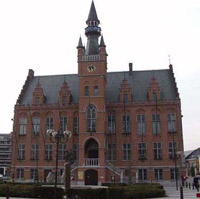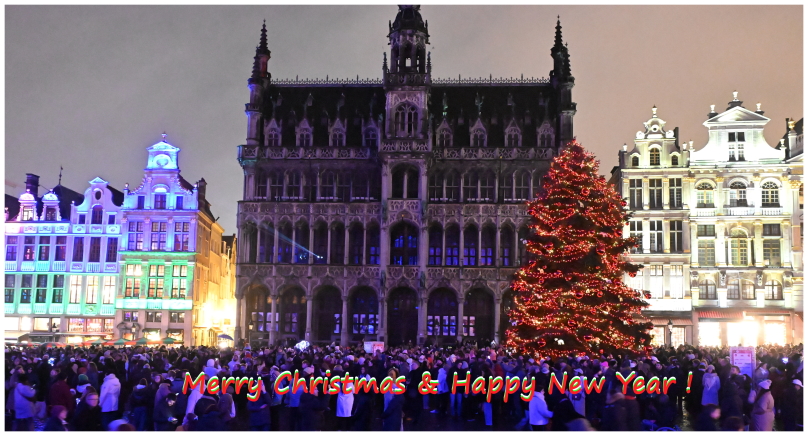The Meetjesland in the north of East-Flanders, Belgium
Maldegem, a Meetjesland town in Belgium
Maldegem was once upon a time a very important town. There were two village priests, one who took care of the souls of the northern part of the town and the other who blessed the southern half. In 1520 they were Johannes van Zuidt and Nicasius van Maldeghem. The latter was at the same time dean of Aardenburg. We can still see his tombstone in one of the walls of the church. There were also three chaplains, one for the altar of St. Barbara, the second for the altar of Notre Dame and the last for the altar of St. Peter. The revenues from the two latter altars were not sufficient for a chaplain. This meant these chaplains didn't always live in their parish but of course they did receive the revenues from their altar.
 |
Maldegem's town hall dates from the beginning of the 20th Century. Picture taken on 19 October 2003, Maldegem's Day of the Horse (Dag van het Paard) |
The tranquil time of the 16th Century ended with the Protestant Troubles "Geuzenberoerten". So much has already been written about that. In 1579 the church of Maldegem was put to the torch and several houses also went up in flames. The nave of the church was so badly damaged it was unusable. Much of the tower was also destroyed and the Saint-Barbara and Saint-Sebastian choirs were also almost totally destroyed. They were now separated from the high choir by a wall. Sloping planks covered with straw were put on the remaining part of the square tower. Maldegem wasn't the only town with a damaged spire. At Ostend for instance they also had only the lower part of their square tower left and like at Maldegem you can still clearly see the square foot of the tower and the octogonal superstructure dating from after the Protestant Troubles.
 In
1620 the two choirs of the Maldegem church were repaired and in 1639 the tower
was rebuilt but the nave of the church had to wait its turn till 1778.
The square part of the spire probably dates from the 14th or
15th Century. The short octogonal part dates from 1639 and was
built with stone from the demolished St Johns Hospital. It had stood where
now stands St Ann's Castle. The church-fabric had to pay the hospital of Bruges
180 pounds for the bricks. The sale of these old bricks had already been
concluded in 1632 and Maldegem town had also taken some for small bridges across
the "Bekewatergang". ("Beke" means little river and
"watergang" means watercourse.) This Bekewatergang was at that
time an open river that ran along the North Street. Maldegem church
received some compensation for these bricks.
In
1620 the two choirs of the Maldegem church were repaired and in 1639 the tower
was rebuilt but the nave of the church had to wait its turn till 1778.
The square part of the spire probably dates from the 14th or
15th Century. The short octogonal part dates from 1639 and was
built with stone from the demolished St Johns Hospital. It had stood where
now stands St Ann's Castle. The church-fabric had to pay the hospital of Bruges
180 pounds for the bricks. The sale of these old bricks had already been
concluded in 1632 and Maldegem town had also taken some for small bridges across
the "Bekewatergang". ("Beke" means little river and
"watergang" means watercourse.) This Bekewatergang was at that
time an open river that ran along the North Street. Maldegem church
received some compensation for these bricks.
Many people were kept busy digging out and cleaning all these building materials. The white stone for the eight corners of the tower came from Balegem and was supplied by Jooris Aerts from Bruges. He was also the building contractor. His contract dates from March 1639 and stipulates that he was to be paid 205 pounds. Immediately the farmers of Maldegem set off for Bruges with horses and carts to fetch the white stone, chalk and wood. For a full day's work of this kind the farmers received 10 shillings and they were allowed a drink at the corporation's inn. For cleaning bricks one was paid two shillings per day plus a pint of beer.
 Early in 1640 the may-pole had
already been planted atop the spire. This meant the masons' work was over
and now two master builders from Ghent came. They were Niclaas De Backere
and Jacob Oosterlinck. Their task was to estimate the value of the work.
They staid for 4 days and received 8 pounds for this plus board and lodgings.
And their estimate was lower than the sum agreed with Master Jooris Aerts.
This meant the church fabric refused to pay all of the 205 pounds mentioned above
and the legal proceedings which followed were won by the builder. This meant
the church fabric had to find an extra 48 pounds to pay intrest. We know the
names of the carpenters but not those of the masons who came from Bruges and were
paid by the contractor.
Early in 1640 the may-pole had
already been planted atop the spire. This meant the masons' work was over
and now two master builders from Ghent came. They were Niclaas De Backere
and Jacob Oosterlinck. Their task was to estimate the value of the work.
They staid for 4 days and received 8 pounds for this plus board and lodgings.
And their estimate was lower than the sum agreed with Master Jooris Aerts.
This meant the church fabric refused to pay all of the 205 pounds mentioned above
and the legal proceedings which followed were won by the builder. This meant
the church fabric had to find an extra 48 pounds to pay intrest. We know the
names of the carpenters but not those of the masons who came from Bruges and were
paid by the contractor.
And as soon as the masons had gone the farmers went off again to bring on the timber. Cornelis De Zuttere from Butswerve supplied a huge oak tree for 8 pounds and 10 shillings. This was an enormous amount of money for a single tree. But it was so heavy no one could transport it so they had to saw it where it laid. And that beam is still the mainstay of the spire. It was a tremendous job to get it installed and of course every able bodied man in the whole town had to help and... had to be regaled with pints of beer when it was all over.
 A staircase and a path
were built in the tower and when the carpenters had finished
their work it was the slaters' turn. The slates were brought via the Lieve
Canal from Ghent to Balgerhoeke
where they were transferred from the boats to the many farmers' carts.
A staircase and a path
were built in the tower and when the carpenters had finished
their work it was the slaters' turn. The slates were brought via the Lieve
Canal from Ghent to Balgerhoeke
where they were transferred from the boats to the many farmers' carts.
Maldegem could permit itself all this thanks to a tax it was allowed to levy on the sale of beer and other alcoholic beverages.
The famous court painter Ivo Ambrosius Vermeersch was born in Maldegem on the
9th of January 1810. He was the youngest son of Maldegem's burgomaster.
He left for Bavaria where he became painter at the court of King Leopold I of
Bavaria. In 1845 he married Amalia de Dahl. Both died on the same day:
24 May 1852.
Sources: "Historische verkenningen in het
Meetjesland" (Historical
Reconnaissance Trips in the Meetjesland), 1982, pp. 83-85 by Daniël Verstraete.
We are indebted to Mr. Paul Van de Woestijne for information on Ivo Ambrosius
Vermeersch in a very interesting article entitled "Meetjeslandse Schilders
in de Memoires of J.B. Lybaert" (Meetjesland Painters in the Memoirs of
J.B. Lybaert) and published in the first issue of 2003 of an excellent quarterly
publication called "Heemkundige bijdragen uit het Meetjesland"
(Regional Contributions from the Meetjesland).
We read in an article entitled "Oud Maldegem" in Ons Meetjesland, 1985, issue 3, about the evolution of the population of Maldegem: in 1801 there were 4261 inhabitants, in 1866 there were 7887, in 1950 it had gone up to 12,700 and in 1967 it stood at 14,248. And in the next issue of Ons Meetjesland (1985, 4) we read, again in "Oud Maldegem" that in 1846 there were 1,158 farms in Maldegem and that 675 of them were 50 ares or less; 50 ares, half a hectare, that's a little over 1.1 acres. What standard of living could a family enjoy on such a small plot of land ? No doubt many of these farmers had other sources of income.
 |
Maldegem has many attractions. One of them is the "Stoomcentrum", the Steam Center. And here we tell you a thing or two about it. |
 |
With great pleasure we show you here a few pictures of Maldegem from the great Romano Tondat Meetjesland Picture Collection. These pictures were taken between 1965 and 1972. |

More pictures
Our Meetjesland
— Table of Contents
— Find something in this Meetjesland website

MijnPlatteLand.com
Most recent update : 05-03-2023
Copyright Notice (c) 2025
